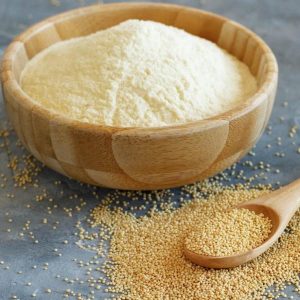Description
Basmati rice is a long-grain rice variety known for its distinctive fragrance, delicate flavor, and slender, elongated grains. It is primarily grown in the Indian subcontinent, particularly in the foothills of the Himalayas, as well as in Pakistan and Iran. Basmati rice is highly prized for its superior quality and is often considered the “king of rice.”
Here are some key characteristics and uses of basmati rice:
1. Fragrance and Flavor: Basmati rice is renowned for its characteristic aroma, often described as nutty or floral, with a subtle hint of pandan or jasmine. This aroma intensifies during cooking, filling the kitchen with a delightful fragrance. Basmati rice also has a delicate flavor and a slightly chewy texture, making it a versatile ingredient in a variety of dishes.
2. Long, Slender Grains: Basmati rice grains are long, slender, and have a distinctive pearly-white appearance. When cooked, the grains remain separate and fluffy, rather than clumping together, making basmati rice ideal for pilafs, biryanis, and other rice-based dishes where each grain should retain its individual shape and texture.
3. Culinary Uses: Basmati rice is a staple ingredient in Indian, Middle Eastern, and Persian cuisines. It is commonly used to make pilafs, biryanis, fried rice, and rice salads. Basmati rice pairs well with a wide range of ingredients, including vegetables, meats, seafood, and spices, making it a versatile base for various savory dishes.
4. Health Benefits: Basmati rice is a nutritious source of carbohydrates and provides energy to the body. It has a low to medium glycemic index, which means it releases glucose into the bloodstream at a slower rate, helping to maintain stable blood sugar levels. Basmati rice is also naturally gluten-free and suitable for individuals with gluten intolerance or celiac disease.
5. Cultural Significance: Basmati rice has cultural and religious significance in many communities. It is often served during festive occasions, celebrations, and religious ceremonies as a symbol of prosperity, abundance, and hospitality. In Indian culture, basmati rice is considered auspicious and is used in various rituals and traditions.
6. Quality and Varieties: Basmati rice is available in several varieties, each with its own unique characteristics and flavor profiles. Some of the most well-known varieties include Traditional Basmati, Super Basmati, 1121 Basmati, and Pusa Basmati. When purchasing basmati rice, it’s essential to look for high-quality brands that offer authentic, aged rice with a strong aroma and uniform grain length.
Basmati rice is readily available in most grocery stores, specialty food stores, and online retailers. It is typically sold in both white and brown varieties, with white basmati rice being the most common. When cooking basmati rice, it’s important to rinse the rice thoroughly before cooking to remove excess starch and ensure fluffy grains. Additionally, the rice-to-water ratio and cooking time may vary depending on the specific recipe and desired texture. Overall, basmati rice is a versatile and flavorful ingredient that adds a touch of elegance to any meal.






Peter –
I’ve been buying this Basmati Rice for years, and it never disappoints. The quality is consistently excellent, with long, slender grains that cook up fluffy and aromatic. I love the delicate flavor and fragrance that it adds to my meals, and it’s become a staple in my pantry. Whether I’m cooking for my family or hosting dinner parties, this Basmati Rice is always a hit.
Haruna –
“I’ve tried many brands of Basmati Rice, but this one stands out for its exceptional quality. The grains are pristine and uniform, with a wonderful fragrance that fills the kitchen as soon as you start cooking. The rice cooks up fluffy and light, with a subtle nutty flavor that is truly delightful. It’s versatile enough to accompany any cuisine, from Indian to Middle Eastern to Asian.